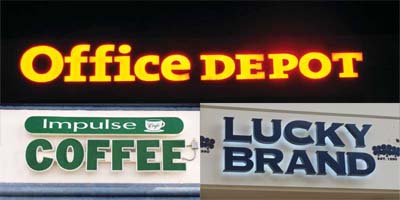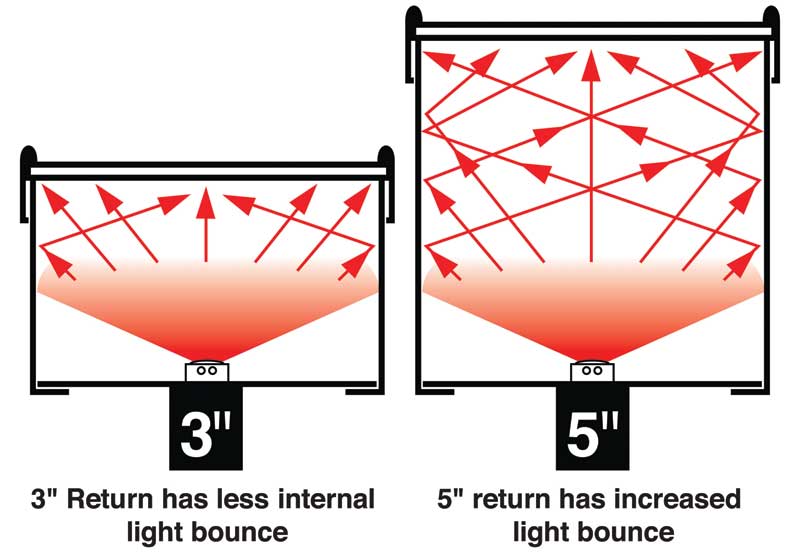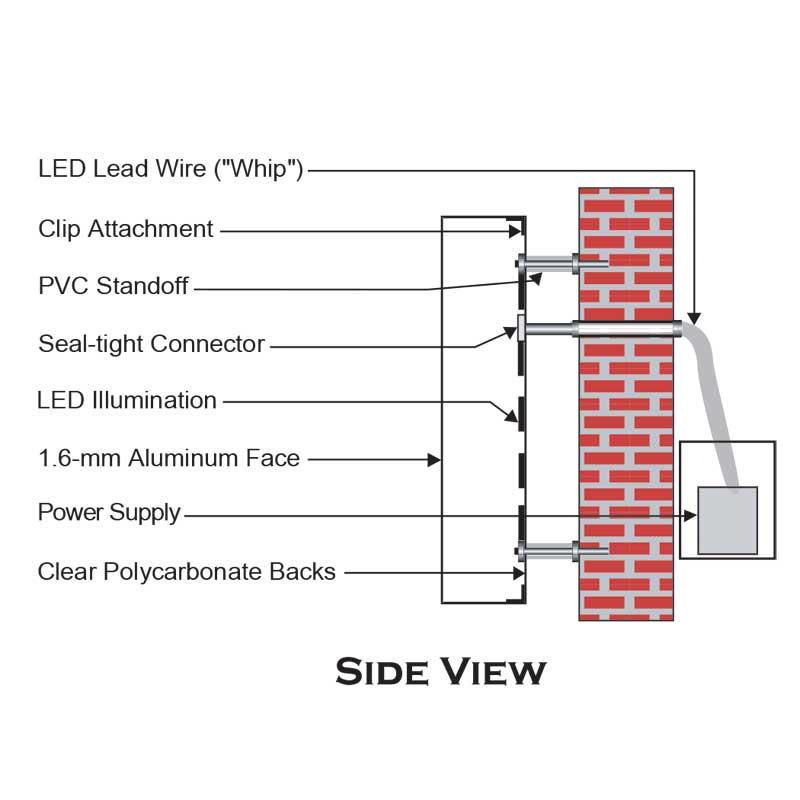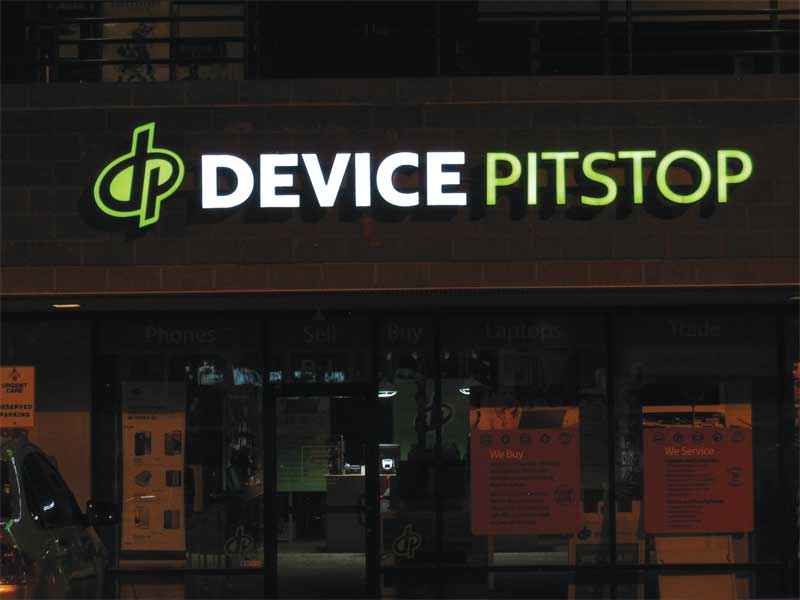LEDs: The challenges of illuminating channel letters
by all | 4 April 2018 2:20 pm
 [1]
[1]Photos courtesy Direct Sign Wholesale
By John Baylis
In recent years, light-emitting diodes (LEDs) have replaced neon as the dominant illumination method for channel-letter signage. Specific methods and principles need to be followed, however, to generate optimal results.
The following are some techniques that can assist in generating peak performance for LED-illuminated channel letters. Some apply to both front- and reverse-lit types of letters, while others are more particular to one than the other.
Front-lit letters
The colour of the acrylic face is an important variable in producing optimal illumination for a front-lit channel letter. Some colours will produce better results than others.
Red, for example, is usually an excellent option for an illuminated sign face. The human eye contains a higher concentration of red photoreceptor cells (i.e. cones) than those for other colours. This is one of the reasons red achieves a high degree of nighttime visibility for channel letters.
Another face colour with strong visibility characteristics for illuminated signs is white, which presents a clear nighttime appearance in part because it reflects all of the colours in the light spectrum. This is why government departments of transportation specify white letters on a green background for highway signs.
There are certain other acrylic face colours, however, that can prove problematic and may not present an optimal appearance at night, regardless of the configuration of the LEDs lighting them, because they tend to absorb—rather than emit—much of the illumination. These include dark blue and dark green.
When clients specify such colours for their channel letter faces, signmakers should inform them about the potential drawbacks in terms of appearance, before their orders are submitted.
With dark blue, by way of example, the eye tends to focus on it slightly in front of—rather than directly on—the retina, causing a ‘halo’ effect to appear around the lighting. This effect can make the illuminated letters difficult to read under certain circumstances.
Burgundy, which is typically specified as a vinyl rather than acrylic face colour, can also prove problematic. It is important to note, however, these guidelines only refer to darker shades of these colours and do not mean the lighter shades of the same should not be used. Indeed, light green can present a fine image for a sign.
 [2]
[2]Figure 1: Return depths
Return depth
Another factor affecting illumination performance for front-lit LED channel letters is the return depth. (The return is the side of a channel letter, i.e. the actual sign can.)
The current standard return depth for front-lit channel letters is 127 mm (5 in.), which will generally provide an excellent performance for letters that are populated
with the appropriate number of LED modules. That said, a 76-mm (3-in.) return depth is also becoming increasingly common today.
The latter configuration offers a few potential advantages in terms of illumination. First, the shorter distance the light must travel from the LED to the face material leads to an overall brighter appearance. Secondly, the shorter return depth reduces ‘ricochet lighting,’ i.e. illumination that bounces off the sides of the letter before reaching the acrylic face (see Figure 1).
So, while a standard return depth can provide perfectly acceptable performance, the shorter return may result in better LED-based illumination for front-lit channel letters.
Stroke width
The stroke width of channel letters is another factor that will affect the performance of LED illumination. (In this context, ‘stroke’ refers to single line or component of the letter, such as the vertical segment of a capital letter ‘T.’)
Periodically, a sign shop’s clients will submit designs for their channel letters with a stroke width of less than 38 mm (1.5 in.). This can cause issues and reduce the performance of LED-based illumination, as a stroke that small does not allow for the correct placement of the modules.
Hence, a good rule of thumb is for all letter strokes to be at least 38 mm wide. And if the customer’s design has specified a smaller stroke, the signmaker should ask if that specification can be altered accordingly, prior to production.
 [3]
[3]Figure 2: Viewing angle
Number of strands
Another important variable in achieving optimal illumination is the number or concentration of LED strands mounted inside the channel letter. If an insufficient number is used, it can result in a poor appearance.
One factor in determining the necessary number of strands is the viewing angle range for each LED module. This range is defined as the area covered by the module’s cone of light before losing 50 per cent of its brightness (see Figure 2).
Such ranges vary between different brands of LEDs, but typically, each interior span of 127 mm (5 in.) requires its own LED module strand. The precise implementation of this common practice will depend on the specific module’s viewing angles.
Return interior paint
Another factor that assists in achieving optimum LED illumination performance is the channel letter’s interior paint or coating.
Highly reflective paint will both enhance the brightness of the illumination and reduce the probability of ‘hot spots,’ i.e. where certain sections of a front-lit letter’s face appear brighter than others.
In comparison, letters where the return’s interior is unfinished will exhibit reduced illumination performance. This guideline applies both front- and reverse-lit channel letters.
 [4]
[4]Figure 3: Wall mounting
Reverse-lit letters
For reverse-lit channel letters, the primary challenge for LED illumination is to produce a halo of sufficient brightness and breadth to provide a complete and legible outline for each of the letters.
It has become a common practice to mount the LED modules to the back of channel letters, rather than to the front of their interior face. In this scenario, the modules are mounted directly onto a clear, thermoformable, impact-resistant polycarbonate sheet that forms the back of each letter. The LEDs’ light is directed toward the inside of the light, but then reflected back out. When configured correctly, this setup can provide an even, balanced halo of light around the letter, as viewed from the front.
Mounting distance
The proper appearance of reverse-lit channel letters depends in part on the capability of the reflected light of the LEDs to fan out from behind to create the halo effect. This capability will vary depending on the letters’ mounting distance from the supporting building’s wall or façade (see Figure 3).
The typical mounting distance for halo-lit channel letters is between 38 and 51 mm (1.5 and 2 in.) from the wall. If the letters are mounted any closer than that minimum distance, then the halo may be compromised and appear too small, making the sign more difficult to read at night.
Return depth
Just as with front-lit letters, the return depth of reverse-lit letters will affect the appearance of their halo illumination.
Generally, a 76-mm return is specified, to provide the optimal degree of reflected light. A 127-mm return may not allow for a sufficiently bright halo.
Façade characteristics
The characteristics of the mounting surface and location must also be taken into account when planning the installation of reverse-lit channel letters with LEDs, as they can have a substantial effect on the presentation of a sign’s halo illumination.
Phenolic wall panels, for example, which are sometimes applied to the exteriors of buildings, have a reflective quality that may negatively affect the appearance of a sign. Their shiny surface can either amplify or distort the halo lighting, to the point where it appears misshapen.
Another issue with mounting a reverse-lit letter set onto a reflective surface is the actual LED modules themselves can become visible within the halo’s reflection on the façade. This becomes more of a concern in situations where the letters are mounted at a lower elevation, closer to the people viewing them.
A façade that has been painted in a substantially different colour from that of the halo lighting may also affect the sign’s appearance, to varying degrees. A bright yellow wall surface, for example, can make white halo lighting appear yellowish, which may not be what the client wants.
Such potential issues should be discussed with the customer prior to the installation of the sign, so as to avoid the element of surprise and to prevent the customer’s displeasure with the letters’ final appearance.
 [5]
[5]Some acrylic face colours will produce better results than others for front-lit letters.
Backer panels
Another technique for optimizing LED-based illumination for reverse-lit letters is to add a backer panel.
A backer panel is basically a contoured aluminum sheet that is specified in a chosen colour and then mounted behind a channel letter set. It may be used with either front- or reverse-lit channel letters, but will only affect the illuminated appearance of the latter.
There are compelling advantages to adding a backer panel for reverse-lit channel letters. First, the panel’s colour can be chosen to blend in with the building façade’s colour, making the difference inconspicuous during the day. Secondly, a backer panel provides an even and neutral surface for the halo illumination.
Overall, a backer panel provides an ideal surface for halo illumination with LEDs. It avoids the problems with colour, texture and reflection that can otherwise result from mounting reverse-lit letters directly to a building’s façade.
Finding the proper configuration
LEDs can provide an effective and economical source of illumination for channel-letter signs, but taking full advantage of their capabilities requires the letter set to be properly configured in the first place, in terms of face colour, return depth and numerous other variables. Incorrect choices with regard to any of these variables can compromise the performance and appearance of the illuminated letters after they have been installed.
John Baylis is marketing director for Direct Sign Wholesale, which produces channel letters. For more information, contact him via e-mail at jb@directsignwholesale.com[6].
- [Image]: https://www.signmedia.ca/wp-content/uploads/2018/04/edit1.jpg
- [Image]: https://www.signmedia.ca/wp-content/uploads/2018/04/5-VS-3-Returns-LED_new_HR.jpg
- [Image]: https://www.signmedia.ca/wp-content/uploads/2018/04/led-viewing-angles-e1522865638260.jpg
- [Image]: https://www.signmedia.ca/wp-content/uploads/2018/04/SIDE-VIEW.jpg
- [Image]: https://www.signmedia.ca/wp-content/uploads/2018/04/Device_Pitstop.jpg
- jb@directsignwholesale.com: mailto:jb@directsignwholesale.com
Source URL: https://www.signmedia.ca/leds-the-challenges-of-illuminating-channel-letters/